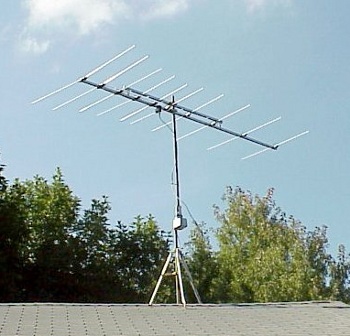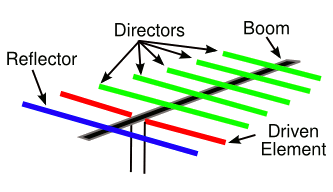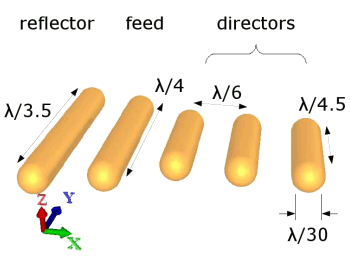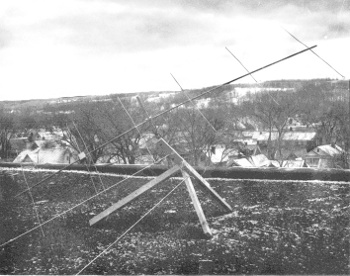Optical Yagi-Uda Nanoantennas
April 25, 2012
Light is an
electromagnetic wave, just like
radio, so it should be possible to scale
radio antenna designs to function for light. The critical dimensions in antennas need to be about the same as the
wavelength of the electromagnetic radiation. That's why
AM radio towers, which transmit
frequencies of about a
megahertz, are more than a hundred
meters high; and the
Wi-Fi antenna on your
wireless router (2.45
GHz) is just a few
inches long.
Since
visible light has a wavelength of about 500
nanometers, optical antennas have only become possible with the advent of routine fabrication of
nanoscale structures. I wrote about optical antennas in the context of
solar energy conversion in a
previous article (Optical Antennas, June 13, 2011).
The
Yagi-Uda antenna has been a popular antenna type for more than eighty years. Its main advantage is that it's directional and offers
gain over the isotropic; that is, it concentrates its electromagnetic
energy in one direction for a
transmitter. For a
receiver, it enhances sensitivity in one direction, while at the same time rejecting
noise away from that direction. This antenna concept was published in
Japanese by
Shintaro Uda and
Hidetsugu Yagi, but it was called a Yagi antenna in the
West, since Yagi published descriptions in
English.

This Yagi-Uda antenna sits atop the roof of my house.
It was part of a my daughter's 1998 science fair project.
The antenna is a Winegard HD6065P High Definition FM Antenna.
(FM Radio Detection of Meteors Web Site))
As shown in the photograph, above, the construction of such antennas is very simple. The principle of operation is related to the concept of
phase interference. The
reflector element (see schematic) is spaced a quarter of a wavelength from the driven element, which leads to
constructive interference for waves in the
plane of the elements and a lesser signal at other angles. The director elements likewise re-radiate energy they receive in a way that enhances the signal of the driven element in the forward direction and diminishes the radiation in other directions.

Schematic diagram of a Yagi-Uda antenna.
(Illustration by author, rendered using Inkscape)
Yagi
patented the concept in 1932,[1] although his patent may seem strange to
radio engineers of today. Yagi showed his directional antenna concept in an array of vertical elements on the ground. This Yagi architecture might be worthwhile resurrecting in an optical analog.
A team of
scientists from the
Nonlinear Physics Centre and the
Centre for Ultrahigh Bandwidth Devices for Optical Systems (CUDOS) of the
Research School of Physics and Engineering, the
Australian National University (
Canberra, Australia) has just published a
preprint of a very thorough review article of the current and potential uses of optical Yagi-Uda antennas.[2] A representative optical nanoantenna is shown in the following figure.

An optical Yagi-Uda antenna based on gold nanorods.
At a wavelength of 1550 nm, the area occupied by the nanoantenna is about 400 x 400 nm.
(Fig. 2 of ref. 2, via the arXiv Preprint Server)[2]
The
Australian authors discuss and compare the
physics behind electromagnetic wave propagation for radio and optical wavelengths; and they analyze the limits for application of this antenna type in the optical domain. Their paper describes some novel
broadband and wavelength tunable Yagi-Uda optical nanoantennas, including arrays of such antennas. Most interesting from a practical viewpoint are the several methods of exciting the active element of such nanoantennas.
One application I found most interesting was the use of paired optical Yagi-Uda antennas to transmit an optical signal across a
chip without the need for an
optical waveguide, as shown in the figure. In a
multichip module, this may even be a means of communicating between chips.

Two optical Yagi-Uda antennas can be used as a mean of transmitting optical signals across a chip, or between chips, without use of an optical waveguide. (Fig. 11 of ref. 2, via the arXiv Preprint Server).[2)]
My first experience with Yagi-Uda antennas was as a
high school senior. I built a
radio telescope as a
science fair project. Shown below is the Yagi-Uda antenna I built from
copper pipes. This
photograph was taken on the roof of my high school, which is now a housing complex for
senior citizens. Perhaps I can get a room there, some day, in the same location as my high school
homeroom. That's what they call
full circle.

My senior high school science fair project included this Yagi-Uda antenna I built from copper piping for a radio telescope.
This photograph shows its placement on the school roof (43.100903° latitude, -75.232664° longitude).
(click for larger image))
References:
- Hidetsugu Yagi, "Variable Directional Electric Wave Generating Device," US Patent No. 1,860,123, May 24, 1932.
- Ivan S. Maksymov, Isabelle Staude, Andrey E. Miroshnichenko and Yuri S. Kivshar, "Optical Yagi-Uda nanoantennas," arXiv Preprint Server, April 2, 2012.
- J.D. Kraus, "Antennas," McGraw-Hill (New York, 1988).
Permanent Link to this article
Linked Keywords: Light; electromagnetic wave; radio; radio antenna; wavelength; AM radio tower; frequency; megahertz; meter; IEEE 802.11; Wi-Fi; wireless router; GHz; inch; visible light; nanometer; nanoscale; solar energy; Yagi-Uda antenna; gain over the isotropic; energy; transmitter; receiver; noise; Japanese language; Shintaro Uda; Hidetsugu Yagi; Western world; West; English language; science fair; Winegard HD6065P High Definition FM Antenna; FM Radio Detection of Meteors Web Site; phase interference; reflector element; constructive interference; plane; Inkscape; patent; radio engineer; scientist; Nonlinear Physics Centre; Centre for Ultrahigh Bandwidth Devices for Optical Systems (CUDOS); Research School of Physics and Engineering; Australian National University; Canberra, Australia; preprint; arXiv Preprint Server; Australia; physics; wideband; broadband; integrated circuit; chip; optical waveguide; multichip module; high school; senior; radio telescope; copper; pipe; Kodak Photographic Film; senior citizen; homeroom; full circle.